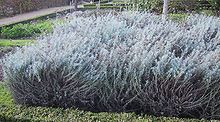
The bay leaf is an aromatic leaf commonly used as a herb in cooking. It can be used whole, either dried or fresh, in which case it is removed from the dish before consumption, or less commonly used in ground form. The flavor that a bay leaf imparts to a dish has not been universally agreed upon, but most agree it is a subtle addition.

Dill is an annual herb in the celery family Apiaceae. It is native to North Africa, Iran, and the Arabian Peninsula; it is grown widely in Eurasia, where its leaves and seeds are used as a herb or spice for flavouring food.

Sumac or sumach is any of about 35 species of flowering plants in the genus Rhus and related genera in the cashew family (Anacardiaceae). Sumacs grow in subtropical and temperate regions throughout every continent except Antarctica and South America. Sumac is used as a spice, as a dye, and in medicine.
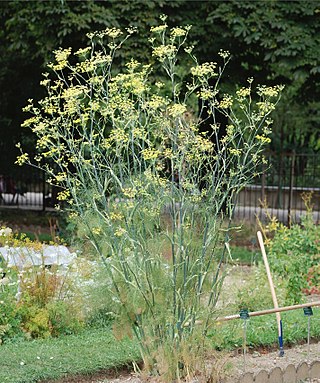
Fennel is a flowering plant species in the carrot family. It is a hardy, perennial herb with yellow flowers and feathery leaves. It is indigenous to the shores of the Mediterranean but has become widely naturalized in many parts of the world, especially on dry soils near the sea coast and on riverbanks.

Allspice, also known as Jamaica pepper, myrtle pepper, pimenta, or pimento, is the dried unripe berry of Pimenta dioica, a midcanopy tree native to the Greater Antilles, southern Mexico, and Central America, now cultivated in many warm parts of the world. The name allspice was coined as early as 1621 by the English, who valued it as a spice that combined the flavours of cinnamon, nutmeg, and clove.
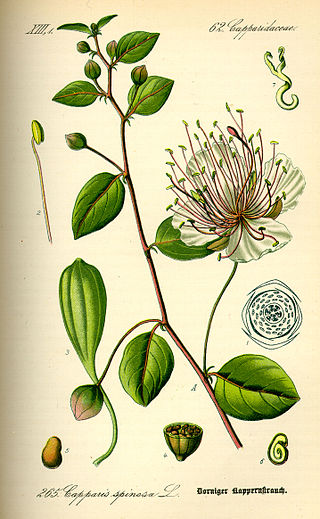
Capparis spinosa, the caper bush, also called Flinders rose, is a perennial plant that bears rounded, fleshy leaves and large white to pinkish-white flowers.

Laurus nobilis is an aromatic evergreen tree or large shrub with green, glabrous (smooth) leaves. It is in the flowering plant family Lauraceae. It is native to the Mediterranean region and is used as bay leaf for seasoning in cooking. Its common names include bay tree, bay laurel, sweet bay, true laurel, Grecian laurel, or simply laurel. Laurus nobilis figures prominently in classical Greco-Roman culture.

Salvia officinalis, the common sage or sage, is a perennial, evergreen subshrub, with woody stems, grayish leaves, and blue to purplish flowers. It is a member of the mint family Lamiaceae and native to the Mediterranean region, though it has been naturalized in many places throughout the world. It has a long history of medicinal and culinary use, and in modern times it has been used as an ornamental garden plant. The common name "sage" is also used for closely related species and cultivars.

Myrtus is a genus of flowering plants in the family Myrtaceae. It was first described by Swedish botanist Linnaeus in 1753.
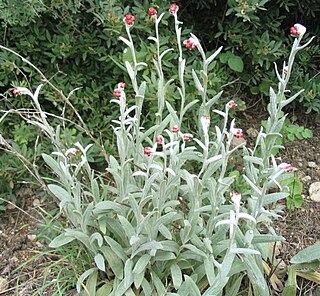
The genus Helichrysum consists of an estimated 600 species of flowering plants in the sunflower family (Asteraceae). The type species is Helichrysum orientale. They often go by the names everlasting, immortelle, and strawflower. The name is derived from the Ancient Greek words ἥλιος and χρῡσός.

The curry tree or Bergera koenigii, is a tropical and sub-tropical tree in the family Rutaceae, native to Asia. The plant is also sometimes called sweet neem, though M. koenigii is in a different family to neem, Azadirachta indica, which is in the related family Meliaceae.
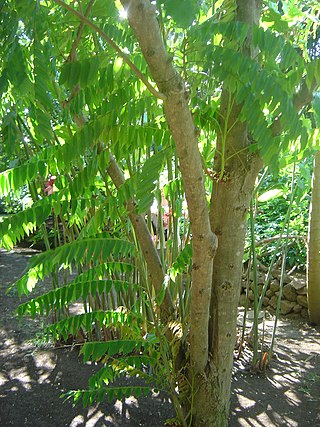
Averrhoa bilimbi is a fruit-bearing tree of the genus Averrhoa, family Oxalidaceae. It is believed to be originally native to the Maluku Islands of Indonesia but has naturalized and is common throughout Southeast Asia. It is cultivated in parts of tropical South Asia and the Americas. It bears edible extremely sour fruits. It is a close relative of the carambola tree.

Brachychiton is a genus of 31 species of trees and large shrubs, native to Australia and New Guinea. Fossils from New South Wales and New Zealand are estimated to be 50 million years old, corresponding to the Paleogene.

Xerochrysum bracteatum, commonly known as the golden everlasting or strawflower, is a flowering plant in the family Asteraceae native to Australia. Described by Étienne Pierre Ventenat in 1803, it was known as Helichrysum bracteatum for many years before being transferred to a new genus Xerochrysum in 1990. It is an annual up to 1 m (3.3 ft) tall with green or grey leafy foliage. Golden yellow or white flower heads are produced from spring to autumn; their distinctive feature is the papery bracts that resemble petals. The species is widespread, growing in a variety of habitats across the country, from rainforest margins to deserts and subalpine areas. The golden everlasting serves as food for various larvae of lepidopterans, and adult butterflies, hoverflies, native bees, small beetles, and grasshoppers visit the flower heads.

Tasmannia lanceolata, commonly known as pepper tree, native pepper, mountain pepper or mountain pepperbush, is a species of flowering plant in the family Winteraceae, and is endemic to south-eastern Australia. It is a dioecious bushy shrub to small tree with lance-shaped or narrowly ellipic leaves, male and female flowers on separate plants, the flowers with 3 to 9 petals, and the fruit a deep maroon to glossy black berry.

Helichrysum panormitanum subsp. melitense, synonym Helichrysum melitense, is a subspecies of flowering plant in the family Asteraceae and is endemic to Malta, specifically to the island of Gozo. It is known as the Maltese everlasting. It can be found in Dwejra, and in cliffs in Gozo near Fungus Rock. Its natural habitats are Mediterranean-type shrubby vegetation on Coastal garigue and vertical sheer cliffs. Recently, it was recorded in new locations on the island of Gozo. This plant is on the decline in the wild, and it is threatened by habitat loss. It is very easy to cultivate, and it is gaining ornamental popularity amongst the locals.

Chrysocephalum semipapposum, commonly known as clustered everlasting is a perennial shrub native to Australia. Clustered everlasting belongs to the family Asteraceae. C. semipapposum produces terminal flowers heads in clusters, mainly between spring and early summer with silver-grey appearing stems and branches. It grows up to 40 cm high and 60 cm high, although there have been some varieties which can grow up to 1 m. C. semipapposum is often confused with Chrysocephalum apiculatum or 'yellow buttons', due to their similar appearances. C. semipapposum has 4 different subspecies, however they lack distinctive qualities and are often hard to identify. C. semipapposum is endemic to Australia and can be found in multiple states, most notably within Victoria. The plant is found in a variety of habitats including dry rocky regions. Clustered everlasting often grows sparsely and is rarely found in abundance and can be mistaken for a weed. Clustered everlasting has many uses, including as a source of nectar for butterflies, cut flowers or as an addition to a garden.

In general use, herbs are a widely distributed and widespread group of plants, excluding vegetables and other plants consumed for macronutrients, with savory or aromatic properties that are used for flavoring and garnishing food, for medicinal purposes, or for fragrances. Culinary use typically distinguishes herbs from spices. Herbs generally refers to the leafy green or flowering parts of a plant, while spices are usually dried and produced from other parts of the plant, including seeds, bark, roots and fruits.
The following outline is provided as an overview of and topical guide to herbs and spices:

Helichrysum stoechas, known as Mediterranean strawflower, curry plant, common shrubby everlasting, everlasting flower, or eternal flower, is an annual or perennial shrub that prefers dry, rocky and sandy areas. It can grow up to 120 centimeters in height, and spreads over 1 square meter in area. It is a hermaphrodite that has grayish green leaves and produces small globular yellow flowers sometimes in the Spring or in July and August that are pollinated by insects.
